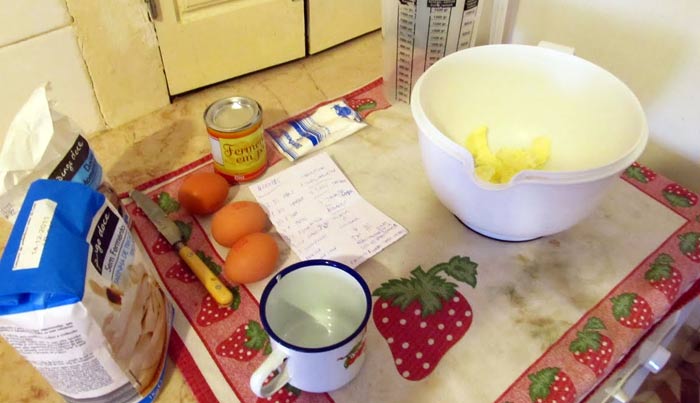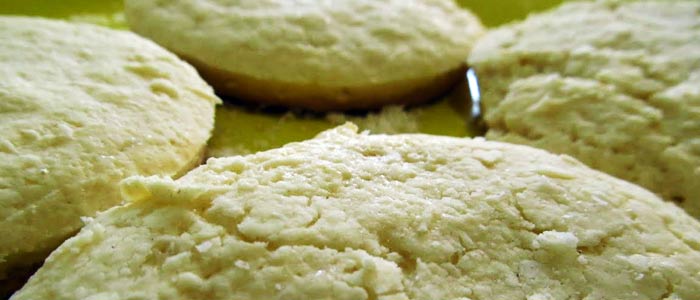As a cook aficionado living away from my home country, I discovered what many people in the same situation usually discover: that you miss the food and ingredients you grew up with. I constantly find myself craving some childhood sweet or a meal my mom used to prepare.
My mom has strongly influenced my cooking, and I’m always revisiting or reinventing her recipes, or at least what I can remember of them. Fortunately, nowadays I just email her whenever I get a blast from the past, and my stomach starts growling for attention.
This time, however, I decided to keep my mom out of the picture while going for an ultimate Argentinian classic: alfajores de maicena stuffed with dulce de leche.

Back in the day, the Arabs somehow took the original alfajor recipe (a spicy and honey-flavored sweet) to Spain, and from there it traveled overseas to the South American colonies, where it became something quite different. Nowadays, we basically call alfajor anything that looks (and tastes) like two cookies stuffed with something sweet and topped with something else that’s sweet.
In Argentina, there are so many brands and types to choose from that you can never get tired of them. Some people have only alfajores for lunch. But one alfajor occupies Argentine people’s minds (and stomachs) more than any other: alfajores de maicena. These beauties are made of a mix of flour and cornstarch (maicena), which produces a dry, buttery and crumbly dough. This original cookie combines divinely with dulce de leche stuffing, a flavor probably familiar to everybody by now.
I’ve been keen to bake some of these sweets since I left Buenos Aires, but somehow I always kept postponing it. Recently, I decided to finally give it a try and went in search of the perfect recipe. But what was keeping me from following my mother’s recipe this time?

Honestly, I always found my mom’s alfajores a bit dry and overly crumbly, with the cookie/dulce de leche ratio falling towards the bald side. So I decided to go for a classic recipe with a few twists that would warrant me a softer and spongier dough: a juicier alfajor. It wasn’t going to be an easy task as I had many factors working against me: my first time preparing a recipe; dealing with a new and unknown oven (which was already showing some bad temper); and worst of all, I was in a part of the world with no access to dulce de leche–oh, how can anybody be deprived of such a basic need? We do live in a cruel cruel world!
So, I had to go for the oldest trick in the book: making my own dulce de leche by double boiling a can of condensed milk until thick and brown; two patient hours and, therefore, plenty of time to prepare the dough.
This recipe calls for approximately two parts of cornstarch for every part of all purpose flour, which produces a delicate dough that has to be handled carefully. It’s a similar process to making pastry or pie crust; the dough should be mixed carefully, incorporated, without any kneading. Save your KitchenAid for other things–this baby prefers the soft caress of your bare hands.
Besides the unusual amount of cornstarch, the rest of the ingredients are common for cookies: baking soda and powder to make it spongy, butter to make it comforting, vanilla essence and lemon zest to make it addictive.
The baking process is also rather simple. They bake fast in an oven set to medium heat. Between 10 and 15 minutes will do; just watch for when the edges start to brown. Of course, this is all in theory; I had to keep turning down the oven heat and moving the tray to the top rack for more even cooking. But even if your oven is as moody as mine, it’s not hard to get it right: at the first sight of brownness, remove the tray from the oven.
To be honest, my worst fear was actually ending up with a dry and crunchy batch of cookies, the very thing I was trying to avoid! Fortunately, there are a few tricks that can still be done to prevent this. One is placing the cookies inside a Tupperware container while they’re still warm and covering them so they get softer in their own steam (a good old crepe and tortilla trick). My other advice is knowing how to get the dulce de leche stuffing amount right. The stuffed dulce de leche starts to get absorbed by the dough if you let the alfajores sit. That will make the dough softer but will also reduce your stuffing. So my advice is, if you’re gonna let them sit, overstuff! I know there’s no such thing as too much dulce de leche. And remember that sprinkling coconut flakes over the edges will keep everything in its right place.

As for me, I knew from the first bite that things had gone well. The cookie dented before crumbling, the dulce de leche oozed and wept with all its sweetness, the subtle and sharp lemon taste appeared at the end. And when I finished that first alfajor, I wanted more more more…
Perdón, mamá, but I don’t regret a thing!